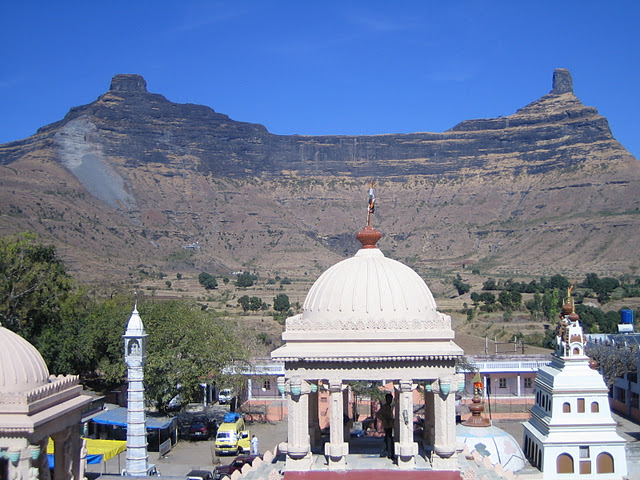Jain Temples and Holy Mountain of Mangi-Tungi
Sacred Mangi-Tungi is located at the end of a side-track in a thinly populated area of scenic grandeur. Rama and Sita on their flight from Ayodhya are said to have sojourned for a while at the foot of the Mangi, the western pinnacle of the twin-peaked holy mountain. Looking out from under the rock-sheltered spot where the princely couple is supposed to have meditated makes one believe in this ancient story.
How and when it came to the excavation of the first caves at such a lofty height is not known. Work may have begun as early as on the Ellora caves which are not far distant, just about 250 kilometres to the south-east. Admittedly, the Mangi-Tungi sculptures lack the perfection and elegance of those found in the Jaina caves at Ellora, but this short-coming may be due to the understandable difficulty the builders must have faced in their search for master-sculptors willing to work at such a remote and dangerously high location (1306 m). Still, the feat of having accomplished the task of working the hard rock to such an extent deserves our admiration. It was no mean undertaking. Before the actual work could begin, round both the Mangi and the Tungi, a circumambulatory passage had first to be cut out of the vertical rock-face. This extra labour and expenditure was not required at Ellora.
 |
Mangi-Tungi: Elevation and bird's-eye view (not to scale) |
Setting out to Mangi-Tungi, climbing the c.3500 steps, beholding from above the widely unspoiled country, and then encompassing the two mighty pinnacles and paying homage to the detached looking Jinas which are likely to outlast the gnawing teeth of time for another so many centuries, could well be an inducement to the pilgrim to delve deeply into that spiritual side of human nature without which a fruitful coming together of visionary conception, determination, faith in oneself and others, artistic skill and workmanship, and dana (the giving of gifts) necessary to transform and sanctify a given piece of land into a tirtha would hardly materialize.
 |
Mangi-Tungi: Image of seated Parshvanatha attended by two standig Tirthankaras. Apart from the Jinas there are rock-cut images representing Yakshas, Yakshis and a Bahubali. |
The three shrines and a large dharmashala at the foot of the mountain, surrounded by a wall, are of recent date. The oldest temple, dedicated to Parshvanatha, was build in 1915, the newest one was completed and inaugurated in 1996. A convenient way of reaching Mangi-Tungi by public bus is from or via Satana or Malegaon. The gate to the temple compound is the final stop of the buses.
Impressions of Jain Temple complex at the foot of Mangi-Tungi









Impressions of Mangi-Tungi Mountain peaks with Jain cave-temples














 Kurt Titze
Kurt Titze
